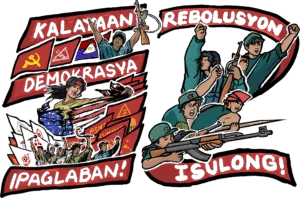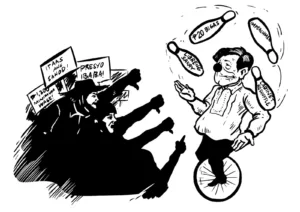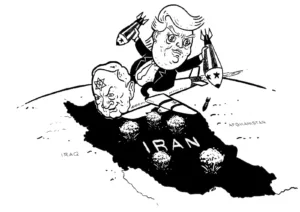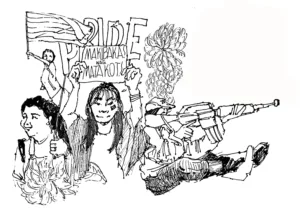The Great Proletarian Cultural Revolution
The reestablishment of the CPP was benefited by the struggle of Marxist-Leninists against the Lava revisionist renegades and by the international struggle led by Comrade Mao against the modern revisionism centered in the Soviet Union. Furthermore, it was benefited by Comrade Mao’s theory and practice of the continuing revolution under proletarian dictatorship, through the Great Proletarian Cultural Revolution begun in 1966, in order to combat revisionism, prevent the restoration of capitalism and consolidate socialism.
Of course, there was a big difference between reestablishing the Communist Party of the Philippines for the immediate purpose of leading the people’s democratic revolution and the phenomenon of the GPCR in socialist China. But we the Marxist-Leninists in the Philippines deeply appreciated the GPCR as the process of preventing the restoration of capitalism in socialist countries and we recognized the great benefit of acquiring foresight and confidence in the historical development of socialism, up to the threshold of communism.
We understood that Comrade Mao brought the theoretical and practical development of Marxism-Leninism to a new and higher level by putting forward the theory and practice of continuing revolution under proletarian dictatorship as the way to ensure the ultimate victory of communism. We had the advantage of sending delegations to China during the GPCR. We had the opportunity to observe the process and listen to the explanations.
Comrade Mao had learned from the earlier experience of the Soviet Union that one could err as Stalin did to declare prematurely the end of classes and class struggle, except the struggle between imperialism and the Soviet people, just because by legal and economic definition capitalists and landlords no longer existed in the Soviet Union. After Stalin, the Soviet revisionist party consistently proclaimed that the mission of the working class had been accomplished. The Chinese revisionists also declared that the class struggle was dying out.
Mao recognized the dangers and disastrous results of denying the existence of classes and class struggle in socialist society and presuming a short socialist transition from capitalism to communism. He stressed that class struggle is the key link and revolutionary politics must be in command. He pointed to the teachings of Lenin that socialism entails a whole historical epoch and that after its defeat in a country the bourgeiosie resists socialism more fiercely by ten-thousand fold, regroups and tries to recover strength in any social sphere or institution to which it can withdraw and keeps availing of the assistance and influence of the international bourgeiosie.
The danger of capitalist restoration comes not only from the remnants of the old bourgeoisie and landlords but from the political degeneration of revolutionary veterans as well as from the children of the workers and peasants who become well educated formally and rise up within the party, state, economy and culture but who become alienated from the working people and take on the petty bourgeois way of acting and behaving until they become full-fledged revisionists.
Having been the pioneer in socialist revolution and construction, the Soviet Union enjoyed great prestige and influence in China after the victory of the Chinese revolution. Quite a number of Chinese revolutionary leaders worshipped the Soviet model, even when this had become outdated, was inapplicable to Chinese conditions or was characterized by revisionism. Then after the 1949 victory of the Chinese revolution, many Chinese students and workers went to the Soviet Union for education and training, exactly when revisionism was gaining ground and upon their return acquired key positions in the bureaucracy and the Party.
The theory and practice of continuing revolution under proletarian dictatorship was impelled by the need to counter the phenomenon of Chinese revisionism that arose not only from Chinese conditions but also took inspiration from Soviet revisionism. Mao had to contend with the Chinese revisionists who used the CPC Eighth Party Congress to undercut the socialist line and who opposed and tried to derail the Great Leap Forward and then the Socialist Education Movement.
Mao put forward the theory and practice of continuing the revolution under proletarian dictatorship in order to revolutionize both the social base and the superstructure of Chinese socialism and ensure the leading position of the working class and its Party, to undertake the cultural revolution as the most extensive form of democracy ever experienced by humankind, to unite the entire Party, proletariat and people against the Party persons in authority taking the capitalist road, to provide the youth with revolutionary experience and train them as revolutionary successors, to continue resolving the contradictions between mental and physical work, between workers and peasants and between town and country, to unite the cadres, the masses and experts in factories, to build the rural industries and expand the scale of the communes, to develop intimate links with the masses and to build the revolutionary people’s committees on a new basis.
Without the GPCR, the socialist line of Mao would have been reversed earlier by the Chinese revisionists. But in carrying out the GPCR, Comrade Mao, the Marxist-Leninists and the entire Chinese people won resounding victories against the revisionists in the ten-year course of the GPCR from 1966 to 1976. The class struggle between the two sides continued to intensify and was not resolved completely. The revisionists were able to maneuver and fight, to make trouble and make a comeback. This explains why soon after the death of Mao the Marxist-Leninists lost power and the revisionists came to power through the combination of the Rightists and Centrists..
Certain errors and shortcomings in the course of the GPCR, enabled the revisionists to gain advantage and maneuver. Factional groupings and factional fighting arose and were at times confusing to the masses. In the course of the mass movement, due process was not rigorously respected and some people suffered persecution. At certain crucial junctures, the Left did not win over the Middle in order to isolate and defeat the Right. Thus, the Right could take advantage of ultra-Left attacks on the Middle. The centrists hardened and succeeded in intrigue at the expense of the Left and the Left split a number of times. With the help of the centrists, the Rightists gained ground and were restored to high offices as early as 1971.
In the Soviet experience, after the death of Stalin, the revisionists came to power after a series of splits among the successors loyal to Stalin from 1954 to 1956. For a long while, from 1956 to 1989, the revisionists pretended to improve on socialism by adopting capitalist reforms. It would only be in 1991 that they openly discarded the flag of the Communist Party, attack the name of Lenin and the entire legacy of Lenin and Stalin, legalize the accumulated capital in the hands of a few and accelerate the full-blown restoration of capitalism. Since then, Russia and other republics of the former Soviet have undergone unprecedented economic, social, political and cultural degradation. So have the former satellites of the Soviet Union in Eastern Europe.
Up to the present, the Communist Party of China remains in power but since the 1976 coup it has completely departed from the revolutionary road under the leadership of Comrade Mao. It has flagrantly adopted and promoted capitalism since the unbridled re-commodification of Chinese labor power, the dismantling of the commune system and the opening to foreign direct investments. Chinese state-owned industries have been dismantled in a big way in favor of private enterprises. The ownership of land is still formally public but in fact the land is made available on a widescale for capitalist profit.
The Chinese economy is extremely lopsided. The foreign-owned sweatshops proliferate in the eastern coast and private construction projects go on in the cities. But the underdevelopment and poverty of most parts of China have deepened and aggravated. Unemployment is rampant. Chinese in huge numbers have been laid off from the dissolved state-owed enterprises. Hundreds of millions of Chinese are migrant workers with extremely low wages and without rights. The peasant masses live under conditions similar to or worse than those before the victory of the revolution in 1949. China may be described as a neocolonial adjunct of the economically far superior imperialist countries if one observes the increasing compradorization and refeudalization of the Chinese economy.
At the same time, there are those who describe China as an emerging imperialist country in certain respects and in certain degrees. Chinese monopoly capital, bureaucratic and private, even if increasingly foreign-controlled and big comprador in character, has a dominant position in the Chinese economy. Bank capital is merged with industrial capital to make finance capital to some extent, even as the banking system is overburdened with huge foreign loans as well as with bad industrial and commercial loans and is in the process of increasingly coming under the control of foreign banks through WTO-instituted “reforms”.
China’s export of surplus capital is still limited in comparison to the foreign investments of the US, Europe and Japan and is certainly too small in comparison to the huge export of goods (mostly with non-Chinese brands) from its sweatshops mainly by China-based foreign monopolies. China participates in alliances with other foreign monopolies through cartels, syndicates and the like but is a mere adjunct of the far more developed imperialist powers. It is not yet a major contender for economic territory (sources of raw materials, markets and fields of investment) and for political territory (colonies, semi-colonies and dependent countries).







